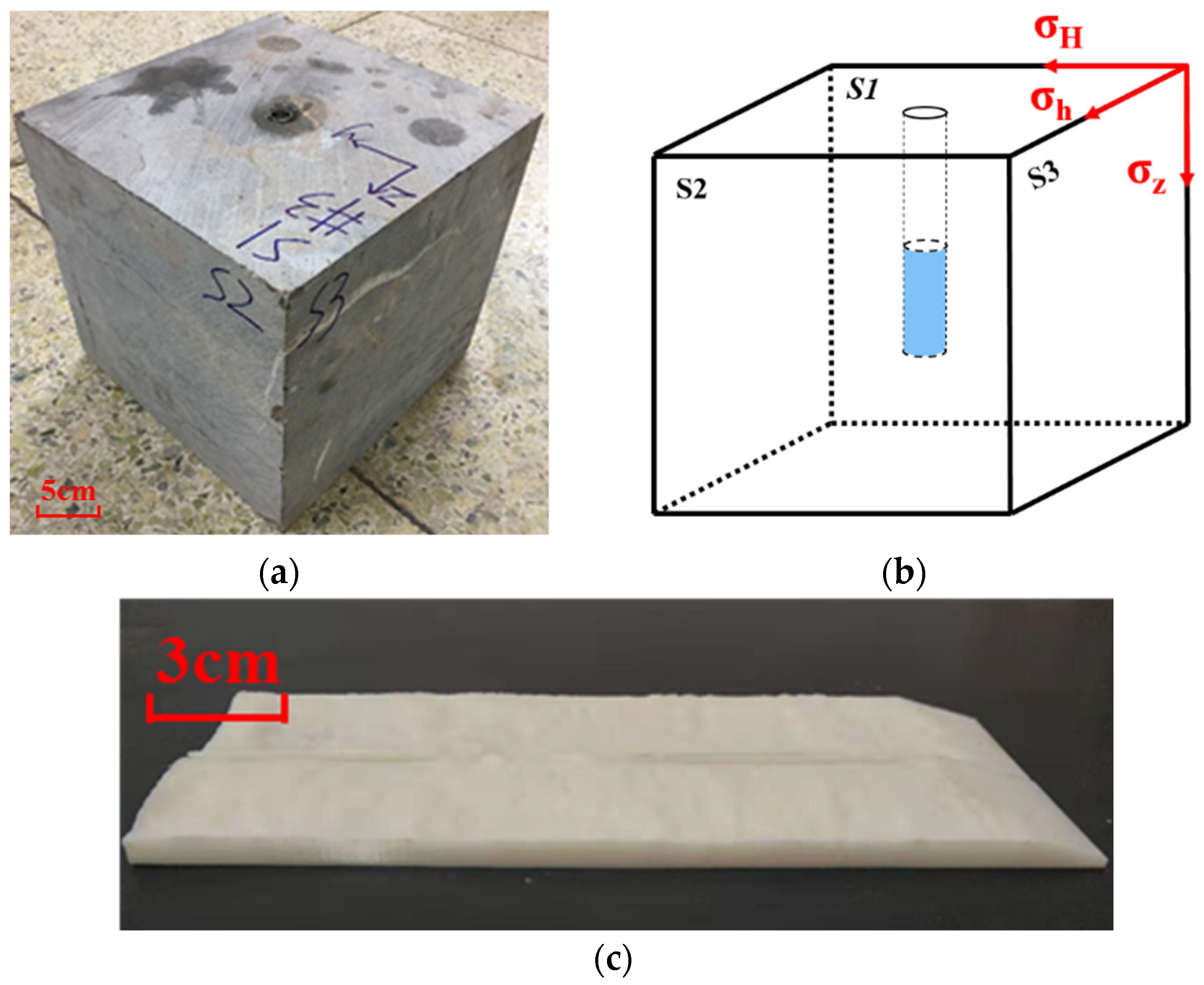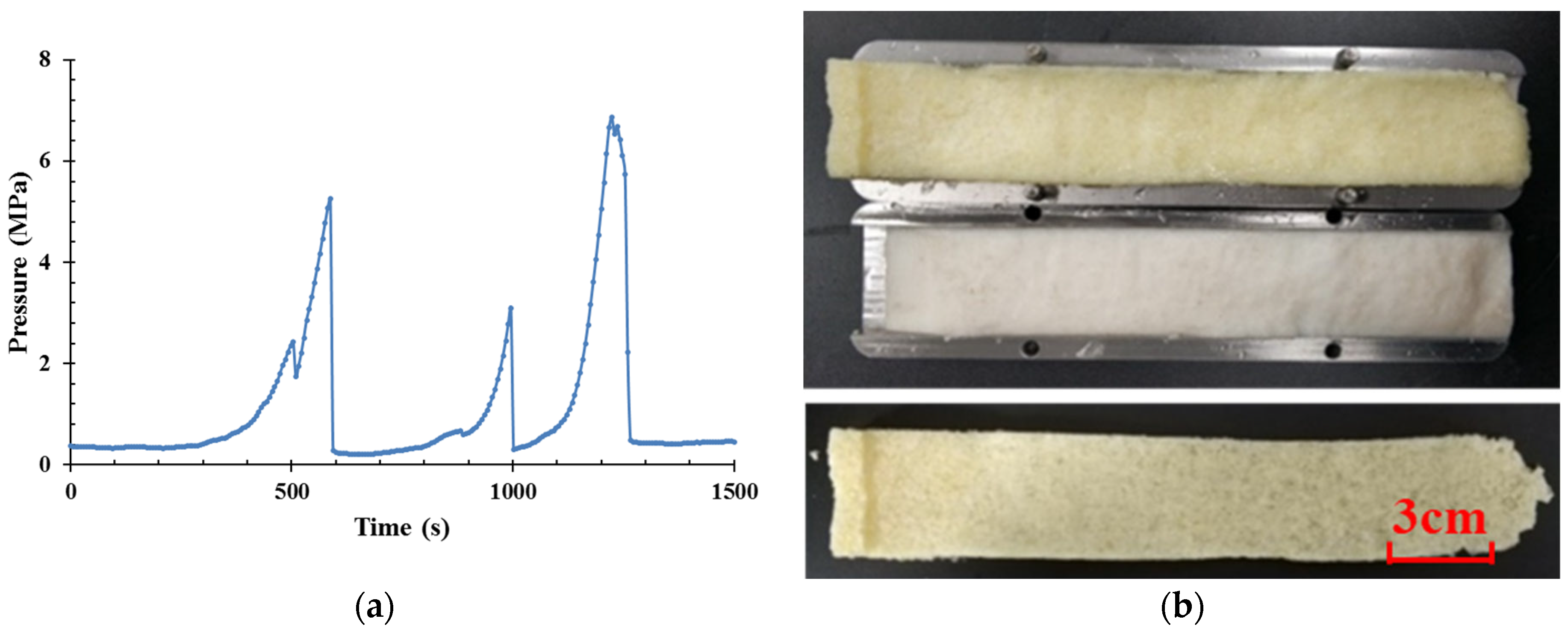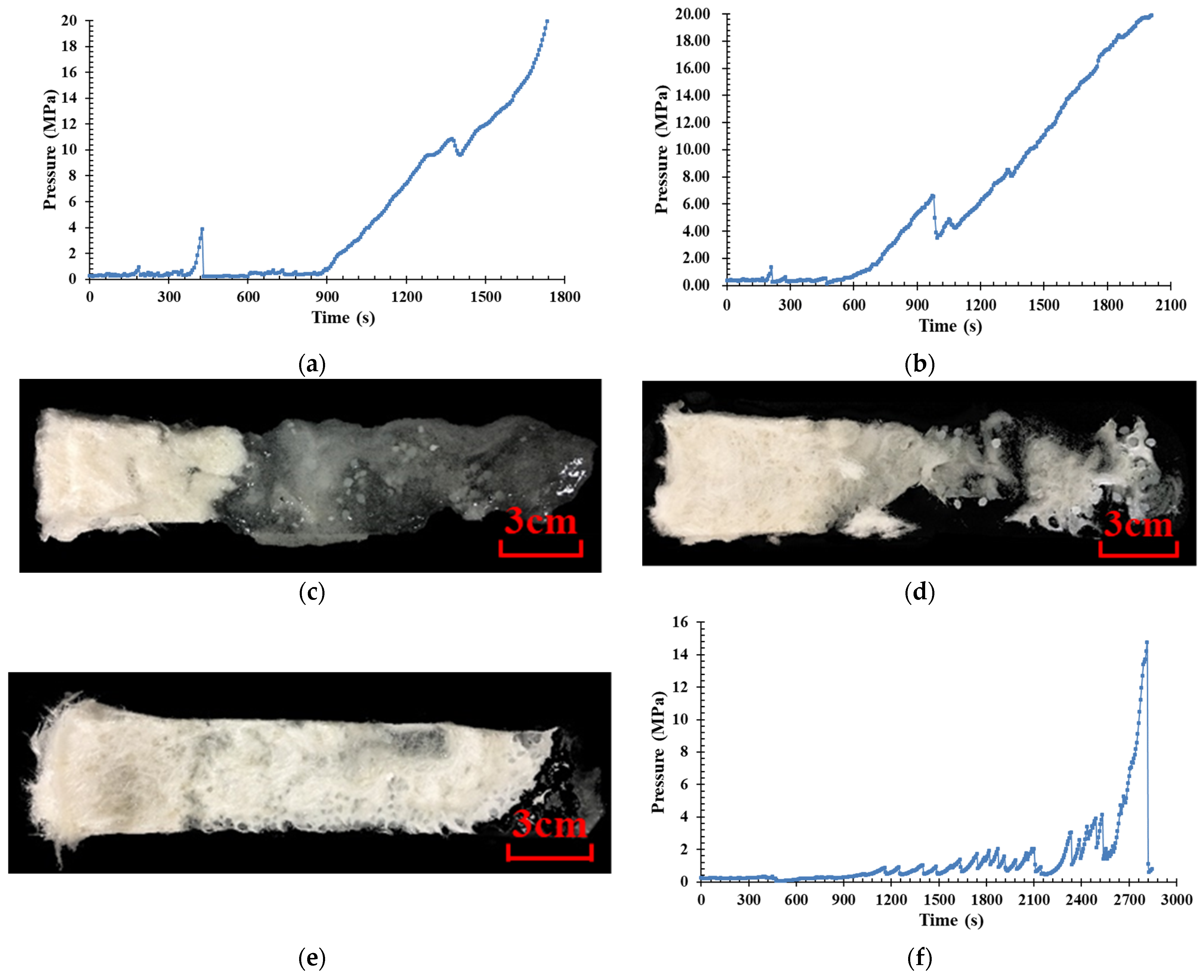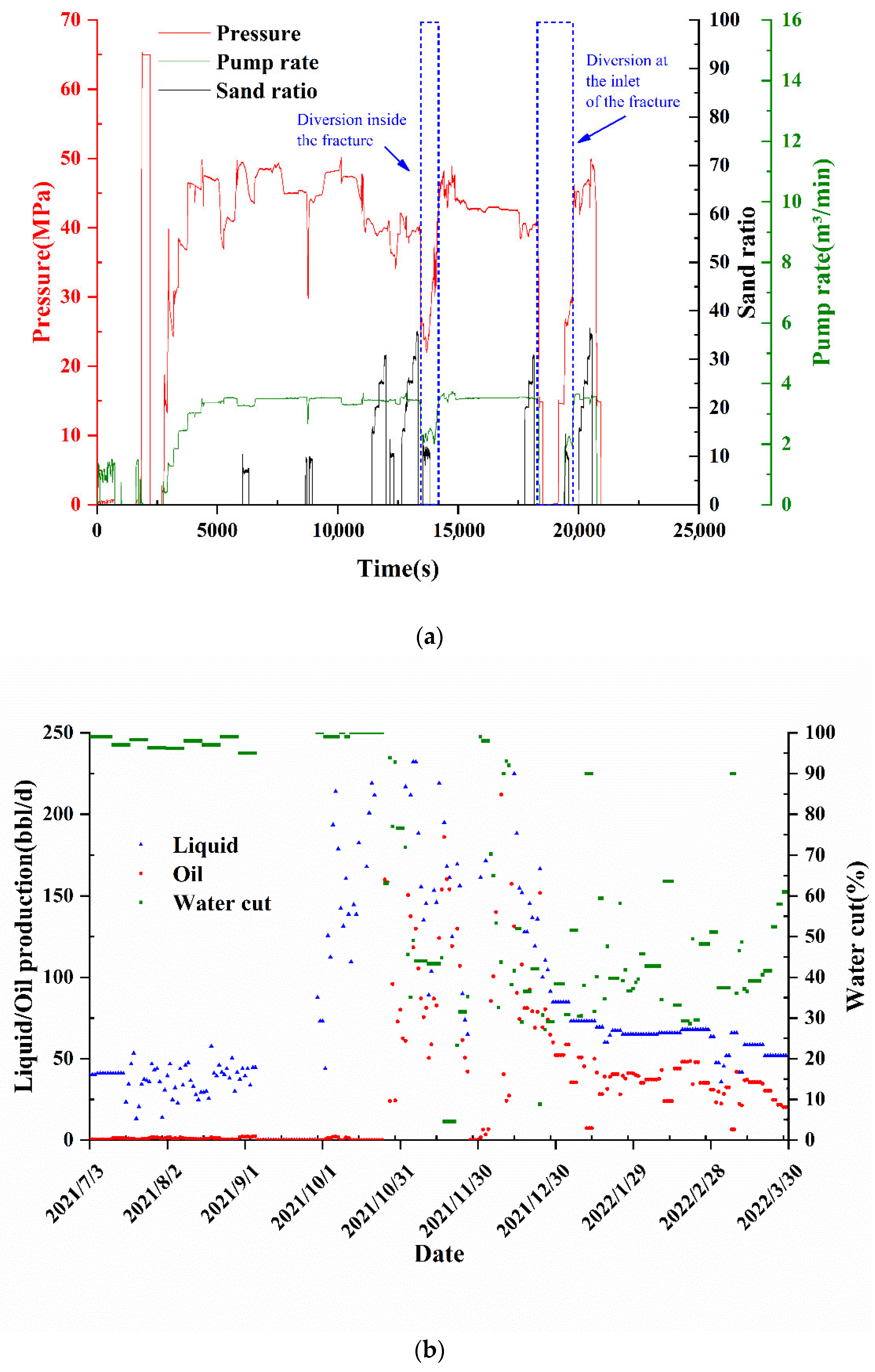Research and Successful Application of the Diverted Fracturing Technology of Spontaneously Selecting Geologic Sweet Spots in Thin Interbedded Formation in Baikouquan Field
Abstract
:1. Introduction
2. Experimental Approach
2.1. Experimental Setup
2.2. Specimen Preparation
2.3. Specimen Preparation
2.4. Experimental Procedure
2.4.1. Triaxial Fracturing Experiment
- Preparation of fracturing fluid.
- 2.
- Specimen fixing.
- 3.
- Stress loading.
- 4.
- Fracturing.
- 5.
- Anatomizing rocks along with fractures.
2.4.2. Diversion Pressure Test of Diversion Agents
- (1)
- Prepare the fracturing fluid containing the diversion agent and put it into the intermediate container;
- (2)
- The 3D printing rock plate is installed in a holder, and the thickness of the shims is adjusted to simulate different slit widths. Then, the holder is spliced together and put into the diversion chamber;
- (3)
- Fix the diversion chamber on the experimental desk, connect its inlet with the intermediate container through a special pipeline, and the outlet leads to the measuring cylinder;
- (4)
- Connect the pressure sensor and open the pressure acquisition software. At the same time, start the syringe pump to inject liquid at a certain displacement. Stop the pump after all the fracturing fluid in the intermediate container flows out or the pump pressure is held up to 20 MPa;
- (5)
- Stop data collection. Take out the 3D printed rock plate and observe the distribution of the diversion agent in the rock plate;
- (6)
- Clean the experimental instruments;
- (7)
- Draw the curve of pressure changing with time, and analyze the experimental data.
2.4.3. Stability and Degradability Evaluation of Diversion Agents
3. Result and Discussion
3.1. Diverted Fracturing Experiment
3.1.1. Diversion Inside the Fracture
3.1.2. Diversion at the Inlet of the Fracture
3.2. Performance Evaluation of Diversion Agent
3.2.1. Diversion Inside the Fracture
3.2.2. Diversion at the Inlet of the Fracture
3.2.3. Evaluation of Stability and Degradability of Diversion Agent
4. Field Application of Diverted Fracturing
4.1. Design Idea of Diverted Fracturing
4.2. Design of Dosage of Diversion Agent
4.3. Design of Pump Schedule
4.4. Design of Pump Schedule
5. Conclusions
- (1)
- The triaxial fracturing experiment shows that diverted fracturing can be achieved by temporarily plugging inside the fracture or at the inlet of the fracture, which can lead to secondary opening of new fractures and complex fracture geometry;
- (2)
- With reference to the actual fracture width of 6 mm, based on experiments of plugging evaluation of temporary plugging agent, a 4 wt% concentration of 1–5 mm granules + 20/60 mesh powder was selected for temporary plugging in the fracture, and by using this scheme, the displacement pressure can reach 6.9 MPa, which can meet the requirement of diversion inside the fracture;
- (3)
- It is appropriate to use 3 wt% concentration of 1–7 mm granules + 20/60 mesh powder + fiber for diversion at the inlet of the fracture. This temporary plugging agent scheme with the granules sized larger than the fracture width can not only hold up a sufficiently high pressure (20 MPa) but also build a temporary plugging zone at a fast speed. At the same time, other experiments show that when the largest granule size is equal to or slightly smaller than the fracture width, a dense temporary plugging zone is formed after multiple attempts of plugging and unsealing. However, when the largest granule size is much smaller than the fracture width, due to the ease of entering the fracture, an effective plugging cannot be formed at the inlet of the fracture, but an effect similar to the diversion inside the fracture can be achieved;
- (4)
- Using the overall fracturing optimization design method, the construction parameters of well b20104 in the Baikouquan reservoir were optimized. Based on the temporary plugging and diverting fracturing technique, a fracturing technology by spontaneously selecting geologic sweet spots was developed for this well. According to the analysis of the operation data, there is a 3–10 MPa pressure increase when there are pump diversion agents, which is a clear sign of fracture diversion. Plugging the fracture mouth gives a faster and a higher pressure incremental. These changes indicate the good adaptability of the fracturing technology of spontaneously selecting geologic sweet spots based on diversion for multiple interbedded, thin, low-permeability layers. Additionally, the post-frac production data also prove the effectiveness of this fracturing technology for Baikouquan oil field. Before this fracturing, the well had almost stopped oil production, while after the stimulation, the initial oil production rate has increased to more than 146 bbl/d.
Author Contributions
Funding
Institutional Review Board Statement
Informed Consent Statement
Data Availability Statement
Conflicts of Interest
References
- Tong, S.K.; Gao, D.L. Basic research progress and development suggestions on hydraulic fracturing. Oil Drill. Prod. Technol. 2019, 41, 15. [Google Scholar] [CrossRef]
- Warpinski, N.R.; Teufel, L.W. Influence of geologic discontinuities on hydraulic fracture propagation. J. Pet. Technol. 1987, 39, 209–220. [Google Scholar] [CrossRef]
- Yang, J.S.; Wang, Y.B.; Li, A.Q.; Chen, Z.H.; Chen, Y.P.; Zou, Y.S. Experimental study on propagation mechanism of complex hydraulic fracture in coal-bed. J. China Coal Soc. 2012, 37, 73–77. [Google Scholar]
- Tan, P.; Jin, Y.; Hou, B.; Han, K.; Zhou, Y.C.; Meng, S.Z. Experimental investigation on fracture initiation and non-planar propagation of hydraulic fractures in coal seams. Pet. Explor. Dev. 2017, 44, 439–445. [Google Scholar] [CrossRef]
- Li, N.; Zhang, S.C.; Ma, X.F.; Zou, Y.S.; Chen, M.; Li, S.H. Experimental study on the propagation mechanism of hydraulic fracture in glutenite formations. Chin. J. Rock Mech. Eng. 2017, 36, 2383–2392. [Google Scholar] [CrossRef]
- Du, Z.H.; Li, J.Q.; Nie, H.L. A Probe of Secondary Deflection Fracturing Treatment in Hydraulic Fractures. Xinjiang Pet. Geol. 2013, 34, 349–353. [Google Scholar]
- Rabie, A.I.; Gomaa, A.M.; Nasr-El-Din, H.A. Hcl/formic in-situ-gelled acids as diverting agents for carbonate acidizing. SPE Prod. Oper. 2012, 27, 170–184. [Google Scholar] [CrossRef]
- Zhao, M.W.; Gao, Z.B.; Dai, C.L.; Sun, X.; Huang, Y.P. Advancement of Temporary Plugging Agent for Fracturing in Oilfield. Oilfield Chem. 2018, 35, 538–544. [Google Scholar] [CrossRef]
- He, C.M.; Chen, H.J.; Wang, W.Y. Diversion Acidizing Used for Carbonate Reservoir: State of The Art and New Development. Pet. Drill. Tech. 2009, 37, 121–126. [Google Scholar] [CrossRef]
- Li, B.; Mou, J.; Zhang, S.; Ma, X.; Zou, Y.; Wang, F. Experimental Study on the Interaction Between CO2 and Rock during CO2 Pre-pad Energized Fracturing Operation in Thin Interbedded Shale. Front. Energy Res. 2022, 10, 825464. [Google Scholar] [CrossRef]
- Bouazza, A.; Gates, W.P.; Ranjith, P.G. Hydraulic conductivity of biopolymer-treated silty sand. Geotech. 2009, 59, 71–72. [Google Scholar] [CrossRef]
- Miller, K.A.; Moore, R.G.; Ursenbach, R.G.; Laureshen, C.J.; Mehta, S.A. Proposed air injection recovery of cold-produced heavy oil reservoirs. J. Can. Pet. Technol. 2002, 41, 3. [Google Scholar] [CrossRef]
- Lu, Z.Y. Progress and Prospect Study on Temporary Plugging Agent for Diverting Fracturing. Sci. Technol. Eng. 2020, 20, 12691–12701. [Google Scholar] [CrossRef]
- Wang, D.; Zhou, F.; Ge, H.; Yang, S.; Ying, L. An experimental study on the mechanism of degradable fiber-assisted diverting fracturing and its influencing factors. J. Nat. Gas Sci. Eng. 2015, 27, 260–273. [Google Scholar] [CrossRef] [Green Version]
- Abdollahi, R.; Esfandyari, H.; Pari, M.N.; Davarpanah, A. Conventional diverting techniques and novel fibr-assisted self-diverting system in carbonate reservoir acidizing with successful case studies. Pet. Res. 2021, 6, 247–256. [Google Scholar] [CrossRef]
- Martin, F.; Jimenez-Bueno, O.; Ocampo, A.G.; Ramirez, G.R. Fiber-assisted self-diverting acid brings a new perspective to hot deep carbonate reservoir stimulation in Mexico. In Proceedings of the SPE Latin American & Caribbean Petroleum Engineering Conference, SPE-138910-MS, Lima, Peru, 1–3 December 2010. [Google Scholar] [CrossRef]
- Wang, D.; Zhou, F.; Ge, H.; Bo, Y.; Zhang, W. The effect of pore pressure on crack propagation in diverting fracturing. In Proceedings of the 52nd US Rock Mechanics/Geomechanics Symposium, ARMA-2018-327, Seattle, WA, USA, 17–20 June 2018. [Google Scholar]
- Liu, H.; Zhao, J.Z.; Hu, Y.Q.; Liu, W.; Hu, G.H.; Li, S.F. Study on mechanism of inducing new fractures for refracturing gas wells. Nat. Gas Ind. 2004, 24, 102–104. [Google Scholar] [CrossRef]










| No. | Location of Temporary Plugging | Scheme | Concentration (wt%) |
|---|---|---|---|
| 1 | Temporary plugging inside the fracture | 1–5 mm granules + 20/60 mesh powder | 2 |
| 2 | 1–4 mm granules + 20/60 mesh powder | 4 | |
| 3 | 1–5 mm granules + 20/60 mesh powder | 4 | |
| 4 | Temporary plugging at the inlet of the fracture | 1–7 mm granules + 20/60 mesh powder | 3 |
| 5 | 1–7 mm granules + 20/60 mesh powder + fiber | 3 | |
| 6 | 1–6 mm granules + 20/60 mesh powder + fiber | 3 | |
| 7 | 1–5 mm granules + 20/60 mesh powder + fiber | 3 | |
| 8 | 1–4 mm granules + 20/60 mesh powder + fiber | 3 |
| No. | Scheme | Concentration (wt%) | Plugging Pressure |
|---|---|---|---|
| 1 | 1–5 mm granules + 20/60 mesh powder | 2 | 0.4 |
| 2 | 1–4 mm granules + 20/60 mesh powder | 4 | 4.5 |
| 3 | 1–5 mm granules + 20/60 mesh powder | 4 | 6.9 |
| 4 | 1–7 mm granules + 20/60 mesh powder | 3 | 11.8 |
| 5 | 1–7 mm granules + 20/60 mesh powder + fiber | 3 | 20 (max) |
| 6 | 1–6 mm granules + 20/60 mesh powder + fiber | 3 | 20 (max) |
| 7 | 1–5 mm granules + 20/60 mesh powder + fiber | 3 | 20 (max) |
| 8 | 1–4 mm granules + 20/60 mesh powder + fiber | 3 | 14.75 |
| Fracturing Location | The First Stage | The Second Stage |
|---|---|---|
| Pumping rate | 3.5 m3/min | 3.5 m3/min |
| Percentage of pad | 87.8% | 73.1% |
| Total liquid | 1020.2 m3 | 1496.3 m3 |
| Total proppant | 33 m3 | 96 m3 |
| Average sand ratio | 23.1 | 21.9 |
| Activities Description | Liquid | Liquid | Cumulative Liquid | Displacement | Sand Ratio | Sand | Proppant | Diversion Agent |
|---|---|---|---|---|---|---|---|---|
| (m3) | (m3) | (m3/min) | (%) | (m3) | (kg) | |||
| Pressure test | water | 7 | 7 | - | - | - | - | - |
| Install protector | 1 | 8 | - | - | - | - | - | |
| Pre-pad | slickwater | 20 | 38 | 1.5–2.5 | - | - | - | - |
| 150 | 188 | 2.5–3.5 | - | - | - | - | ||
| 14.3 | 202.3 | 3.5 | 7 | 1.0 | 40/70 mesh quartz sand | - | ||
| 150 | 352.3 | 3.5 | - | - | - | - | ||
| 11.1 | 363.4 | 3.5 | 9 | 1.0 | 40/70 mesh quartz sand | / | ||
| 150 | 513.4 | 3.5 | - | - | - | - | ||
| Pad | jelly | 30 | 543.4 | 3.5 | - | - | - | - |
| Proppant | jelly | 6.7 | 550.1 | 3.5 | 15 | 1.0 | 20/40 mesh quartz sand | - |
| jelly | 10 | 560.1 | 3.5 | 20 | 2.0 | 20/40 mesh quartz sand | - | |
| jelly | 12 | 572.1 | 3.5 | 25 | 3.0 | 20/40 mesh quartz sand | - | |
| jelly | 4 | 576.1 | 3.5 | 30 | 1.0 | 20/40 mesh quartz sand | - | |
| Flush | raw liquor | 7.5 | 583.6 | 3.5 | - | - | - | - |
| Pad | raw liquor | 10 | 593.6 | 3.5 | 10 | 1.0 | 40/70 mesh quartz sand | |
| Pad | jelly | 20 | 613.6 | 3.5 | - | - | - | - |
| Proppant | jelly | 6.7 | 620.3 | 3.5 | 15 | 1.0 | 20/40 mesh quartz sand | - |
| jelly | 5 | 625.3 | 3.5 | 20 | 1.0 | 20/40 mesh quartz sand | - | |
| jelly | 12 | 637.3 | 3.5 | 25 | 3.0 | 20/40 mesh quartz sand | - | |
| jelly | 6.7 | 644 | 3.5 | 30 | 2.0 | 20/40 mesh quartz sand | - | |
| jelly | 2.9 | 646.9 | 3.5 | 35 | 1.0 | 20/40 mesh quartz sand | - | |
| Flush | raw liquor | 7.5 | 654.4 | 3.5 | - | - | - | - |
| Temporary plugging | slickwater | 10 | 664.4 | 2.0 | 10 | 1.0 | 40/70 mesh quartz sand | 280.0 |
| Pad | slickwater | 230 | 894.4 | 3.5 | - | - | - | |
| Pad | jelly | 25 | 919.4 | 3.5 | - | - | - | - |
| jelly | 10 | 929.4 | 3.5 | 20 | 2.0 | 20/40 mesh quartz sand | - | |
| jelly | 8 | 937.4 | 3.5 | 25 | 2.0 | 20/40 mesh quartz sand | - | |
| jelly | 4 | 941.4 | 3.5 | 30 | 1.0 | 20/40 mesh quartz sand | - | |
| Flush | raw liquor | 7.5 | 948.9 | 3.5 | - | - | - | - |
| Stop the pump and inject the diversion agent | ||||||||
| Temporary plugging | raw liquor | 10 | 958.9 | 3.5 | 10 | 1.0 | 40/70 mesh quartz sand | 160.0 + 40 temporary plugging balls |
| Pad | jelly | 20 | 978.9 | 3.5 | - | - | - | - |
| Proppant | jelly | 6.7 | 985.6 | 3.5 | 15 | 1.0 | 20/40 mesh quartz sand | - |
| jelly | 5 | 990.6 | 3.5 | 20 | 1.0 | 20/40 mesh quartz sand | - | |
| jelly | 12 | 1002.6 | 3.5 | 25 | 3.0 | 20/40 mesh quartz sand | - | |
| jelly | 6.7 | 1009.3 | 3.5 | 30 | 2.0 | 20/40 mesh quartz sand | - | |
| jelly | 2.9 | 1012.2 | 3.5 | 35 | 1.0 | 20/40 mesh quartz sand | - | |
| Flush | raw liquor | 8 | 1020.2 | 3.5 | - | - | - | - |
| Total | - | - | 1020.2 | - | 23.1 | 33.0 | - | - |
Publisher’s Note: MDPI stays neutral with regard to jurisdictional claims in published maps and institutional affiliations. |
© 2022 by the authors. Licensee MDPI, Basel, Switzerland. This article is an open access article distributed under the terms and conditions of the Creative Commons Attribution (CC BY) license (https://creativecommons.org/licenses/by/4.0/).
Share and Cite
Tang, C.; Xu, W.; Li, B.; Xin, H.; Zhang, X.; Tian, H.; Mou, J. Research and Successful Application of the Diverted Fracturing Technology of Spontaneously Selecting Geologic Sweet Spots in Thin Interbedded Formation in Baikouquan Field. Energies 2022, 15, 5208. https://doi.org/10.3390/en15145208
Tang C, Xu W, Li B, Xin H, Zhang X, Tian H, Mou J. Research and Successful Application of the Diverted Fracturing Technology of Spontaneously Selecting Geologic Sweet Spots in Thin Interbedded Formation in Baikouquan Field. Energies. 2022; 15(14):5208. https://doi.org/10.3390/en15145208
Chicago/Turabian StyleTang, Chuanyi, Wenxi Xu, Baiyang Li, Huazhi Xin, Xiaoshuan Zhang, Hui Tian, and Jianye Mou. 2022. "Research and Successful Application of the Diverted Fracturing Technology of Spontaneously Selecting Geologic Sweet Spots in Thin Interbedded Formation in Baikouquan Field" Energies 15, no. 14: 5208. https://doi.org/10.3390/en15145208
APA StyleTang, C., Xu, W., Li, B., Xin, H., Zhang, X., Tian, H., & Mou, J. (2022). Research and Successful Application of the Diverted Fracturing Technology of Spontaneously Selecting Geologic Sweet Spots in Thin Interbedded Formation in Baikouquan Field. Energies, 15(14), 5208. https://doi.org/10.3390/en15145208






